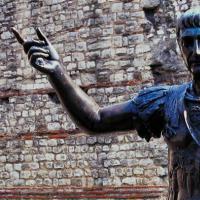Masaccio: paintings and biography
Tommaso Masaccio, whose paintings make a grand step forward from medieval painting to the Early Renaissance, was the first to update all existing traditions. The genius was poorly understood by his contemporaries, only Brunelleschi considered his untimely death a crushing loss. In this article, we will present to your attention Masaccio's paintings with titles and his biography.
early years
The baby was born on 12/21/1401 in the family of a young notary who lived near Florence. He was baptized and named after Tommaso di Ser Giovanni di Guidi. At the age of five, the baby was left without a father, who died suddenly. His pregnant mother, having given birth to her second son, soon married a pharmacist who had 2 daughters. But this marriage did not last long. At the age of 15, Tommaso lost his stepfather and headed the family.
In Florence
Researchers suggest that in 1418 the whole family had already moved to Florence. There is a lot of controversy about who Masaccio's teachers were. The most likely answer: architect Brunelleschi and sculptor Donatello. They were older and more experienced than their student and generously shared with him discoveries in a linear perspective and a new awareness of the personality of a person filled with spiritual life. The drama of Donatello, the sharpness of his transmission of passion will later enter the paintings of Masaccio.
First works
By our standards, a young man, and according to people of the 15th century, a completely adult person became the breadwinner of the family, having received the first work orders. Already in 1422, a large triptych was completed for the church of St. Juvenal. In the central part of the triptych, the use of perspective is especially evident, creating a depth of space.
The floor of all three panels converges at one point, which is hidden behind the Madonna's head. In the child, depicted as a strict cold sculpture, one can feel the influence of Donatello. The following year, together with Masolino, he painted a triptych for the chapel in the church of Santa Maria Maggiore. It depicts a dramatic episode from the life of St. Juvenal, whom the devil tricked into killing his own parents. This work is poorly preserved, like many paintings by Masaccio.
Active continuation of work
In 1423, the young artist was accepted into the guild of St. Thomas, who was considered the patron saint of painters, sculptors, and architects. As if anticipating that life will be short, the young master works hard and fruitfully, forgetting about himself. Hence the nickname: "Careless" or, as we say, "Masaccio". The most famous will be Masaccio's paintings "Expulsion from Paradise", "St. Peter heals the sick with his shadow”, “The Miracle with the Satyr”, “Madonna and Child”, “Baptism of Neophytes” and others, which we will discuss below. His main principle in his work was the depiction of the world as the artist himself saw it. He sought to comprehend the nature of man and things. Knowledge of perspective, the proportions of the human body, the ability to express emotional experiences in the movements of the body - all these were integral qualities of Masaccio's painting.
Individual style

Masaccio's painting "Trinity" has become the most striking expression of the master's style. This fresco was painted for the church of Santa Maria Novella. The time of its writing has not been reliably established. The composition is built inside an arch, the vault of which goes into the depths. If you look from the bottom up, you can see the ascent to eternal salvation. In the foreground is a sarcophagus with a skeleton, which reminds of the transience of earthly life. Then two figures of customers on their knees. Prayer is salvation for them. The Virgin Mary and John the Theologian are connected by Christ, who is supported by God the Father and the Holy Spirit, hovering over them like a dove. The vanishing point is at the feet of Christ, Mary points to them with her hand.
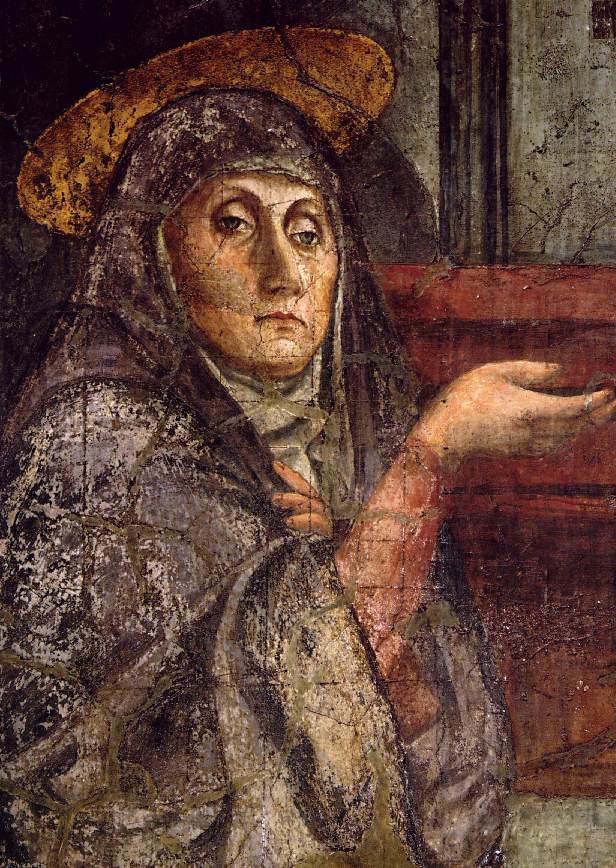
In the Dominican Church, this scene is understood as the affirmation of resurrection as the only answer to death: Christ is risen, and we will all be resurrected. It is believed that this is the most famous painting by Masaccio.
"Madonna and Child" (1426)
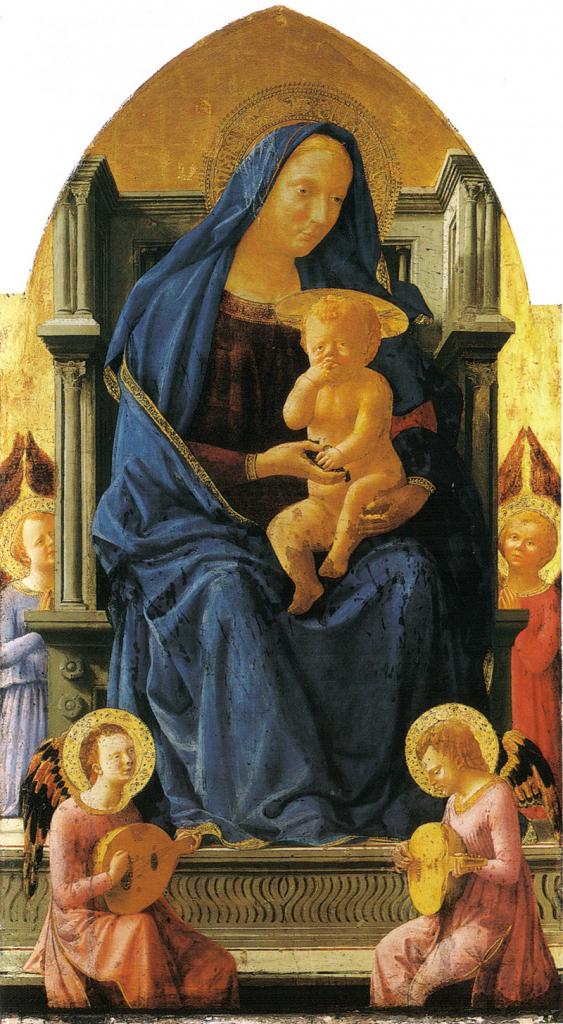
It was a triptych, which is now divided into parts and is in different museums. We will consider the central part: the Madonna on the throne with the child and four angels. Characteristic view of the artist from the bottom up. This is required to take into account the real point of view of a person. The composition is triangular, and the eye falls directly on the baby, who, like a cocoon, is wrapped in a cloak. He sucks grapes, which symbolizes the wine of communion, the future blood shed by Christ.
Frescoes in the Brancacci Chapel in Florence (1425 - 1428)
It identifies as unconditional the artist's works related to the pinnacle of his work - "The Miracle with the Stater", "St. Peter healing the sick with his shadow”, “Saints Peter and John giving alms”, “Expulsion from Paradise”. These works are an indisputable breakthrough from medieval traditions to the new art of the Early Renaissance. All the characters emphasize their physicality both in color and in generalized modeling.
Masaccio, "Expulsion from Paradise": description of the painting
Based on a biblical story. The artist depicted the completely nude figures of his models with great naturalness. The experiences of both characters are also revealed to them extremely clearly.
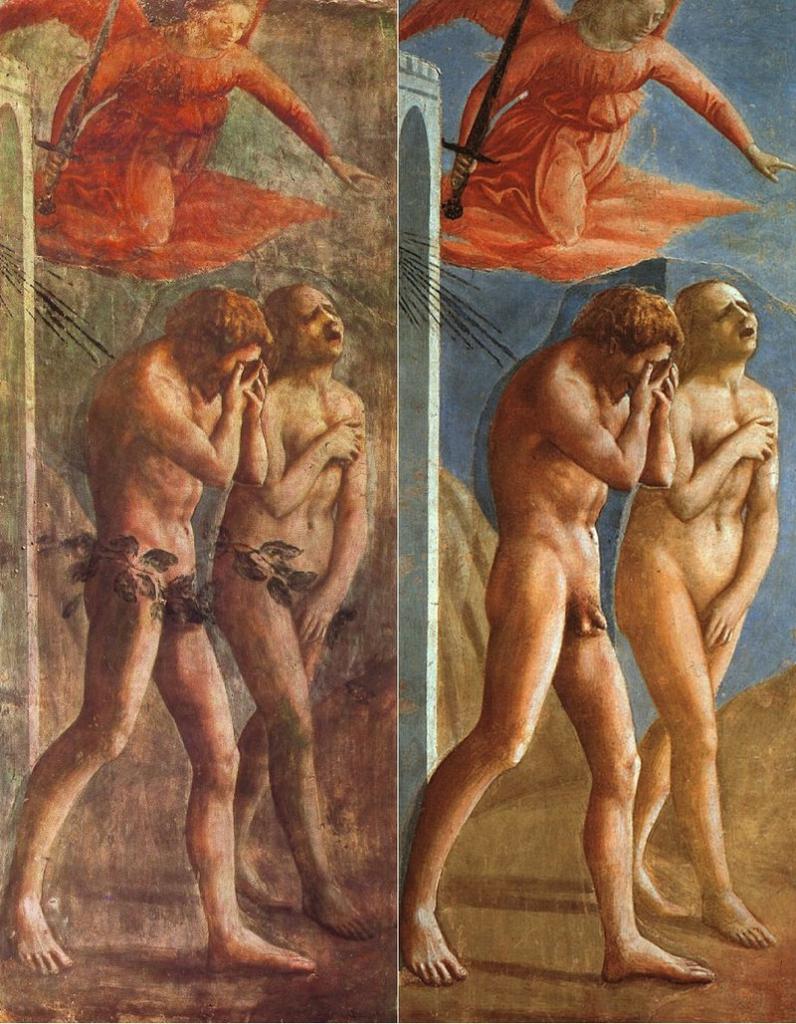
Crying Adam covers his face with his hand. He is filled with bitterness and shame. Suffering bent his body. Eva, covering herself with her hands, screams, as if in excruciating pain, not embarrassed by her feelings. In them - bewilderment, shame, horror. This cry resounds in the souls as the hymn of the mass "Day of Wrath" (Dies irae), that is, the terrible Day of Judgment, where sinners are uprooted into Hell. Masaccio's painting "The Expulsion from Paradise" for the first time shows how two sufferers actually walk, leaning on a full foot. In the old tradition, the figures only lightly touched the ground with their toes. Later, many tried to repeat this technique of his, but practically no one managed to convey the exact angle of Masaccio. At the request of the monks, the naked bodies were later covered with twigs with leaves: the medieval false modesty and the perception of nudity as something dirty and vile were still in effect. A punishing angel with a sword in his hands, hovering over Adam and Eve, tells us that there is no way back for them.
"The Miracle with the Stater"
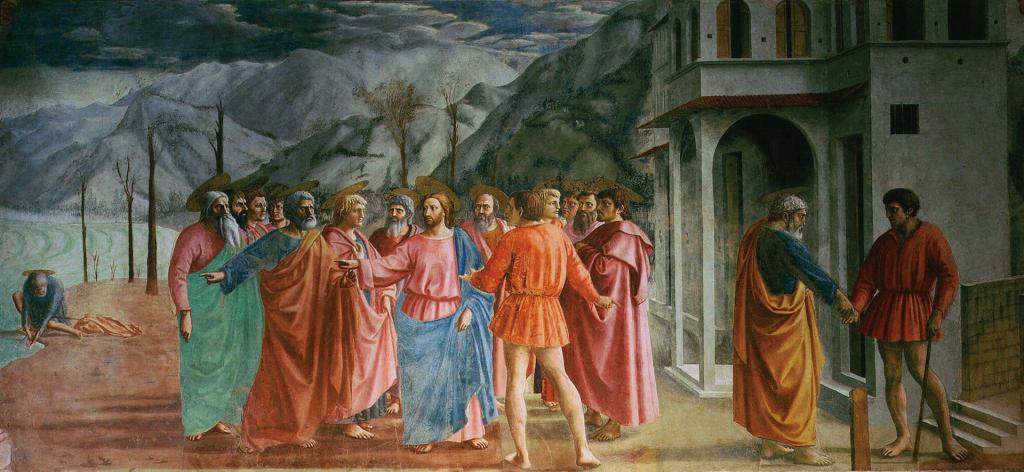
Sometimes this fresco is considered the best. Indeed, she is very interesting. Christ with the apostles came to Caperanum. To enter, it was required to pay a small tax, but they had no money. The Messiah (the compositional and spiritual center of the fresco) gave the order to Peter to catch a fish and get the necessary coin out of it - a stater. All episodes are depicted on one fresco. In the middle, Christ with the disciples in a semicircle gives an order to Peter. On the left, Peter, in a very realistic pose with the exact position of his legs, caught a fish and takes out a coin from it. On the right, he gives it to the tax collector. The composition is linear and the action seems to be continuous. Each character has a distinct personality. Among them, according to Vasari, there is a self-portrait of the master. Including the artist created a living landscape that has never been seen before. Behind - hilly mountains, on the right - the walls of the city, which are made up of empty and full loggias. The light source is on the right and determines the slope of all shadows. Masaccio modeled all the figures with the help of color and light and gave them a sculptural monumentality. It was a pictorial revolution for that time.
"St. Peter healing the sick with his shadow
This small fresco also decorates the Brancacci Chapel. Like all other works of the chapel, it suffered greatly from the fire of 1771, but a comprehensive restoration was carried out in 1983 - 1990, which returned the master's work to its former brilliance. She attracted our attention not so much with her biblical story, although it is also interesting, but with the fact that the man in the red cap is a portrait of the artist Masolino, with whom Masaccio collaborated for a long time. The second portrait - a man with hands folded as if in prayer - is perhaps the great Donatello himself, and the third, John, is presumably the brother of Masaccio.

The gospel scene is very eloquent. St. Peter and John follow him down the street. Their faces are blank. They have no hesitation in helping the sick. The shadow of Peter, falling on a group of patients, raises them to their feet. Here one, with a bandaged leg, has already stood up, the other is still sitting, but he felt that divine grace touched him, the third is waiting for his turn.
In the chapel, the light falls on the fresco from the right. Accordingly, to the left on it are the shadows on a narrow medieval street, where the strict laws of perspective are observed: the houses that go into the distance are reduced in size. This concludes our review of Masaccio's paintings with descriptions.
Moving to Rome and death of the artist
Around 1428, Masaccio leaves unfinished work in the Brancacci Chapel and departs for Rome. It is believed that he was invited by Masolini to perform more prestigious orders. It is not known how many months passed when suddenly Masaccio died unexpectedly. The painter's brother said that he was 27 years old at that time. That is, it happened between December 1428 and the beginning of 1430.
The genius of Masaccio deeply influenced the further development of painting. His work was studied and copied by subsequent generations of artists who raised art to unprecedented heights. The creative discoveries of Masaccio changed the painting not only in Italy, but throughout Europe.


